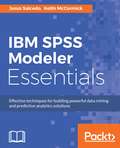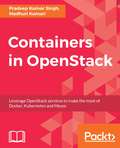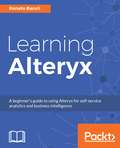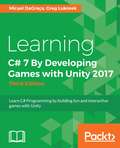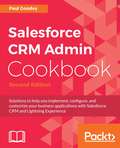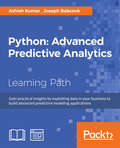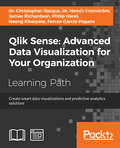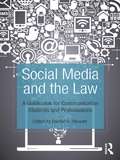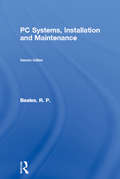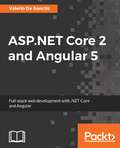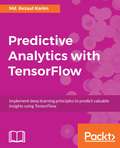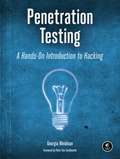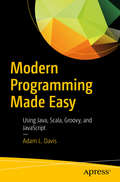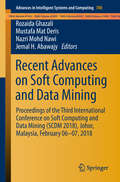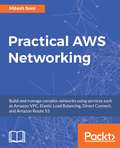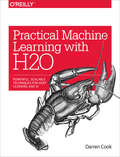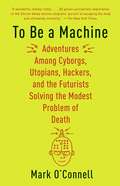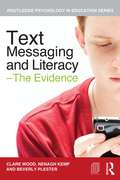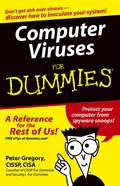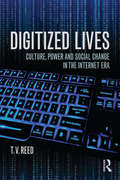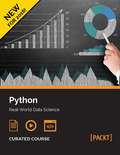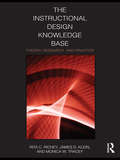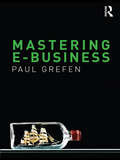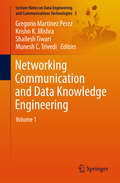- Table View
- List View
IBM SPSS Modeler Essentials: Effective techniques for building powerful data mining and predictive analytics solutions
by Keith McCormick Jose Jesus Salcedo Bowen WeiKey Features Get up–and-running with IBM SPSS Modeler without going into too much depth. Identify interesting relationships within your data and build effective data mining and predictive analytics solutions A quick, easy–to-follow guide to give you a fundamental understanding of SPSS Modeler, written by the best in the business Book Description IBM SPSS Modeler allows users to quickly and efficiently use predictive analytics and gain insights from your data. With almost 25 years of history, Modeler is the most established and comprehensive Data Mining workbench available. Since it is popular in corporate settings, widely available in university settings, and highly compatible with all the latest technologies, it is the perfect way to start your Data Science and Machine Learning journey. This book takes a detailed, step-by-step approach to introducing data mining using the de facto standard process, CRISP-DM, and Modeler’s easy to learn “visual programming” style. You will learn how to read data into Modeler, assess data quality, prepare your data for modeling, find interesting patterns and relationships within your data, and export your predictions. Using a single case study throughout, this intentionally short and focused book sticks to the essentials. The authors have drawn upon their decades of teaching thousands of new users, to choose those aspects of Modeler that you should learn first, so that you get off to a good start using proven best practices. This book provides an overview of various popular data modeling techniques and presents a detailed case study of how to use CHAID, a decision tree model. Assessing a model’s performance is as important as building it; this book will also show you how to do that. Finally, you will see how you can score new data and export your predictions. By the end of this book, you will have a firm understanding of the basics of data mining and how to effectively use Modeler to build predictive models. What you will learn Understand the basics of data mining and familiarize yourself with Modeler’s visual programming interface Import data into Modeler and learn how to properly declare metadata Obtain summary statistics and audit the quality of your data Prepare data for modeling by selecting and sorting cases, identifying and removing duplicates, combining data files, and modifying and creating fields Assess simple relationships using various statistical and graphing techniques Get an overview of the different types of models available in Modeler Build a decision tree model and assess its results Score new data and export predictions
Containers in OpenStack: Leverage OpenStack services to make the most of Docker, Kubernetes and Mesos
by Vinoth Kumar Selvaraj Felipe Monteiro Venkatesh Loganathan Pradeep Kumar Singh Madhuri KumariKey Features Gets you acquainted with containerization in private cloud Learn to effectively manage and secure your containers in OpenStack Practical use cases on container deployment and management using OpenStack components Book Description Containers are one of the most talked about technologies of recent times. They have become increasingly popular as they are changing the way we develop, deploy, and run software applications. OpenStack gets tremendous traction as it is used by many organizations across the globe and as containers gain in popularity and become complex, it’s necessary for OpenStack to provide various infrastructure resources for containers, such as compute, network, and storage. Containers in OpenStack answers the question, how can OpenStack keep ahead of the increasing challenges of container technology? You will start by getting familiar with container and OpenStack basics, so that you understand how the container ecosystem and OpenStack work together. To understand networking, managing application services and deployment tools, the book has dedicated chapters for different OpenStack projects: Magnum, Zun, Kuryr, Murano, and Kolla. Towards the end, you will be introduced to some best practices to secure your containers and COE on OpenStack, with an overview of using each OpenStack projects for different use cases. What you will learn Understand the role of containers in the OpenStack ecosystem Learn about containers and different types of container runtimes tools. Understand containerization in OpenStack with respect to the deployment framework, platform services, application deployment, and security Get skilled in using OpenStack to run your applications inside containers Explore the best practices of using containers in OpenStack.
Learning Alteryx: A beginner's guide to using Alteryx for self-service analytics and business intelligence
by Alok Khobragade Mayur Ravindra Narkhede Renato BarutiKey Features Experience the power of codeless analytics using Alteryx, a leading Business Intelligence tool Uncover hidden trends and valuable insights from your data across different sources and make accurate predictions Includes real-world examples to put your understanding of the features in Alteryx to practical use Book Description Alteryx, as a leading data blending and advanced data analytics platform, has taken self-service data analytics to the next level. Companies worldwide often find themselves struggling to prepare and blend massive datasets that are time-consuming for analysts. Alteryx solves these problems with a repeatable workflow designed to quickly clean, prepare, blend, and join your data in a seamless manner. This book will set you on a self-service data analytics journey that will help you create efficient workflows using Alteryx, without any coding involved. It will empower you and your organization to take well-informed decisions with the help of deeper business insights from the data.Starting with the fundamentals of using Alteryx such as data preparation and blending, you will delve into the more advanced concepts such as performing predictive analytics. You will also learn how to use Alteryx’s features to share the insights gained with the relevant decision makers. To ensure consistency, we will be using data from the Healthcare domain throughout this book. The knowledge you gain from this book will guide you to solve real-life problems related to Business Intelligence confidently. Whether you are a novice with Alteryx or an experienced data analyst keen to explore Alteryx’s self-service analytics features, this book will be the perfect companion for you. What you will learn Create efficient workflows with Alteryx to answer complex business questions Learn how to speed up the cleansing, data preparing, and shaping process Blend and join data into a single dataset for self-service analysis Write advanced expressions in Alteryx leading to an optimal workflow for efficient processing of huge data Develop high-quality, data-driven reports to improve consistency in reporting and analysis Explore the flexibility of macros by automating analytic processes Apply predictive analytics from spatial, demographic, and behavioral analysis and quickly publish, schedule Share your workflows and insights with relevant stakeholders
Learning C# 7 By Developing Games with Unity 2017: Learn C# Programming by building fun and interactive games with Unity
by Predrag Končar Predrag Koncar Micael DaGraçaKey Features This is a step-by-step guide to learn the fundamentals of C# 7 scripting to develop GameObjects and master the basics of the new UI system in Unity Build and develop your 2D game right from scratch while implementing the principles of object-oriented programming and coding in C# 7 Get to grips with the fundamentals of optimizing your game using the latest features of Unity 2017 Book Description Do you want to learn C# programming by creating fun and interactive games using the latest Unity 2017 platform? If so, look no further; this is the right book for you. Get started with programming C# so you can create 2D and 3D games in Unity. We will walk you through the basics to get you started with C# 7 and its latest features. Then, explore the use of C# 7 and its latest functional programming capabilities to create amazing games with Unity 2017. You will create your first C# script for Unity, add objects into it, and learn how to create game elements with it. Work with the latest functional programming features of C# and leverage them for great game scripting. Throughout the book, you will learn to use the new Unity 2017 2D tool set and create an interactive 2D game with it. You will make enemies appear to challenge your player, and discover some optimization techniques for great game performance. At the end, you will learn how to transform a 2D game into 3D, and you will be able to skill up to become a pro C# programmer with Unity 2017! What you will learn Create your first 2D and 3D games in Unity Understand the fundamentals of variables, methods, and code syntax in C# Use loops and collections efficiently in Unity to reduce the amount of code Develop a game using object-oriented programming principles Implement simple enemy characters into the game to learn point-to-point movement and Tree behaviors Avoid performance mistakes by implementing different optimization techniques Export 3D models and animations and import them inside a Unity project
Salesforce CRM Admin Cookbook.: Solutions to help you implement, configure, and customize your business applications with Salesforce CRM and Lightning Experience
by Paul Goodey Fabrice CathalaKey Features Implement advanced user interface techniques to improve the look and feel of Salesforce CRM. Discover hidden features and hacks that extend standard configuration to provide enhanced functionality and customization. Build real-world process automation using detailed recipes to harness the full power of Salesforce CRM. Book Description Salesforce CRM is a market-leading customer relationship management (CRM) application that is accessed over the internet. This application greatly enhances a company's sales performance, improves customer satisfaction, and provides a robust customer relationship management system for an organization. Salesforce CRM Admin Cookbook, Second Edition enables you to instantly extend and unleash the power of Salesforce CRM and its Lightning Experience framework. It provides clear, comprehensive instructions along with detailed screenshots and code. Whether you are looking for solutions to enhance the core features, such as data management, process automation, data validation, and home page administration, or are looking for ideas on advanced customization techniques, this book will provide you with immediate, practical, and exciting real-world recipes. This book guides you through interesting topics spanning a variety of functional areas. Recipes are provided that allow you to configure, build and extend the capability of Salesforce CRM using the Lightning Experience framework. What you will learn Building home page components and creating custom links to provide additional functionality and improve the Home Tab layout Improving the look and feel of Salesforce CRM with the presentation of graphical elements using advanced user interface techniques Improving the data quality in Salesforce CRM and automatic data capture Implement an approval process to control the way approvals are managed for records in Salesforce CRM Increase productivity using tools and features to provide advanced administration Extend Lightning Experience Record Pages to tailor user interaction experience Create Lightning component to implement Search before Create for customer/person accounts
Python: Gain practical insights by exploiting data in your business to build advanced predictive modeling applications
by Joseph J Ashish KumarKey Features A step-by-step guide to predictive modeling including lots of tips, tricks, and best practices Learn how to use popular predictive modeling algorithms such as Linear Regression, Decision Trees, Logistic Regression, and Clustering Master open source Python tools to build sophisticated predictive models Book Description Social Media and the Internet of Things have resulted in an avalanche of data. Data is powerful but not in its raw form; it needs to be processed and modeled, and Python is one of the most robust tools out there to do so. It has an array of packages for predictive modeling and a suite of IDEs to choose from. Using the Python programming language, analysts can use these sophisticated methods to build scalable analytic applications. This book is your guide to getting started with predictive analytics using Python. You'll balance both statistical and mathematical concepts, and implement them in Python using libraries such as pandas, scikit-learn, and NumPy. Through case studies and code examples using popular open-source Python libraries, this book illustrates the complete development process for analytic applications. Covering a wide range of algorithms for classification, regression, clustering, as well as cutting-edge techniques such as deep learning, this book illustrates explains how these methods work. You will learn to choose the right approach for your problem and how to develop engaging visualizations to bring to life the insights of predictive modeling. Finally, you will learn best practices in predictive modeling, as well as the different applications of predictive modeling in the modern world. The course provides you with highly practical content from the following Packt books: 1. Learning Predictive Analytics with Python 2. Mastering Predictive Analytics with Python What you will learn Understand the statistical and mathematical concepts behind predictive analytics algorithms and implement them using Python libraries Get to know various methods for importing, cleaning, sub-setting, merging, joining, concatenating, exploring, grouping, and plotting data with pandas and NumPy Master the use of Python notebooks for exploratory data analysis and rapid prototyping Get to grips with applying regression, classification, clustering, and deep learning algorithms Discover advanced methods to analyze structured and unstructured data Visualize the performance of models and the insights they produce Ensure the robustness of your analytic applications by mastering the best practices of predictive analysis
Qlik Sense: Create smart data visualizations and predictive analytics solutions
by Ferran Garcia Pagans Neeraj Kharpate Henric Cronström James Richardson Philip HandKey Features Get a practical demonstration of discovering data for sales, human resources, and more using Qlik Sense Create dynamic dashboards for business intelligence and predictive analytics Create and collaborate comprehensive analytical solutions using Rattle and Qlik Sense Book Description Qlik Sense is powerful and creative visual analytics software that allows users to discover data, explore it, and dig out meaningful insights in order to make a profit and make decisions for your business. This course begins by introducing you to the features and functions of the most modern edition of Qlik Sense so you get to grips with the application. The course will teach you how to administer the data architecture in Qlik Sense, enabling you to customize your own Qlik Sense application for your business intelligence needs. It also contains numerous recipes to help you overcome challenging situations while creating fully featured desktop applications in Qlik Sense. It explains how to combine Rattle and Qlik Sense Desktop to apply predictive analytics to your data to develop real-world interactive data applications. The course includes premium content from three of our most popular books: [*] Learning Qlik Sense: The Official Guide Second Edition [*] Qlik Sense Cookbook [*] Predictive Analytics using Rattle and Qlik Sense On completion of this course, you will be self-sufficient in improving your data analysis and will know how to apply predictive analytics to your datasets. Through this course, you will be able to create predictive models and data applications, allowing you to explore your data insights much deeper. What you will learn Build simple visualization models with Rattle and Qlik Sense Desktop Get to grips with the life cycle and new visualization functions of a Qlik Sense application Discover simple ways to examine data and get it ready for analysis Visualize your data with Qlik Sense's engaging and informative graphs Build efficient and responsive Associative Models Optimize Qlik Sense for sales, human resources, and demographic data discovery Explore various tips and tricks of navigation for the Qlik Sense® front end Develop creative extensions for your Qlik Sense® dashboard
Federal IT Capital Planning and Investment Control (with CD)
by Thomas G. Kessler DBA Cisa Patricia A. Kelley DPAReduce risk and improve the overall performance of IT assets! Federal IT Capital Planning and Investment Control is the first book to provide a comprehensive look at the IT capital planning and investment control (CPIC) process. Written from a practitioner's perspective, this book covers a range of topics designed to provide both strategic and operational perspectives on IT CPIC. From planning to evaluation, this valuable resource helps managers and analysts at all levels realize the full benefits of the CPIC process. •Explore the full range of IT investment principles and practices •Learn CPIC project management techniques including earned-value management, integrated baseline review, cost-benefit analysis, and risk-adjusted cost and schedule estimates •Identify strategies to improve how your organization manages its IT portfolio and selects, controls, and evaluates investments •Discover how to leverage scarce IT resources and align investments with program priorities •Benefit from the in-depth coverage—excellent for the experienced as well as those new to the CPIC process
Social Media and the Law: A Guidebook for Communication Students and Professionals
by Daxton R. “Chip” StewartSocial media platforms like Facebook, Twitter, Pinterest, YouTube, and Flickr allow users to connect with one another and share information with the click of a mouse or a tap on a touchscreen—and have become vital tools for professionals in the news and strategic communication fields. But as rapidly as these services have grown in popularity, their legal ramifications aren’t widely understood. To what extent do communicators put themselves at risk for defamation and privacy lawsuits when they use these tools, and what rights do communicators have when other users talk about them on social networks? How can an entity maintain control of intellectual property issues—such as posting copyrighted videos and photographs—consistent with the developing law in this area? How and when can journalists and publicists use these tools to do their jobs without endangering their employers or clients? In Social Media and the Law, eleven media law scholars address these questions and more, including current issues like copyright, online impersonation, anonymity, cyberbullying, sexting, and WikiLeaks. Students and professional communicators alike need to be aware of laws relating to defamation, privacy, intellectual property, and government regulation—and this guidebook is here to help them navigate the tricky legal terrain of social media.
PC Systems, Installation and Maintenance
by R. P. BealesWritten in a straightforward, easy to read style, Rob Beales provides the knowledge and techniques needed to build, troubleshoot, and maintain personal computer systems.Divided into three parts, Part 1 forms an introduction to digital computers, leading the reader through the various parts of a modern PC system, including popular peripherals and networking concepts. Part 2 contains a step-by-step guide on the assembly and configuration of a complete state-of-the-art PC system, including a section on the use of important Windows 98 / ME / 2000 / XP applications and components. Part 3 covers preventative, predictive and corrective maintenance, based in typical current work practice – a major part of the IT practitioner’s work schedule.Case Studies and practical worked examples are included throughout the text, with additional Case Studies, specifically aimed to meet the requirements of e-Quals courses on an accompanying website. Further web resources include key figures from the text available to download in full-colour, with a wealth of extra material covering Binary / Hex and basic logic functions; ASCII tables; Connector types and pinouts; Bus slots; RAM slots and further useful website links.Updated throughout in line with current technologies, the second edition is also designed to cover the latest specifications of BTEC National and City and Guilds e-Quals (400 and 500) courses, and the A+ certification, in addition to meeting the needs of the general PC user.
ASP.NET Core 2 and Angular 5: Full-Stack Web Development with .NET Core and Angular
by Valerio De SanctisDevelop a simple, yet fully-functional modern web application using ASP.NET Core MVC, Entity Framework and Angular 5. About This Book • Based on the best-selling book ASP.NET Core and Angular 2 • Easily build a complete single page application with two of the most impressive frameworks in modern development, ASP.NET Core and Angular • Bring together the capabilities and features of both Angular 5 and ASP.NET Core 2 for full stack development • Discover a comprehensive approach to building your next web project-From managing data, to application design, through to SEO optimization and security Who This Book Is For This book is for seasoned ASP.NET developers who already know about ASP.NET Core and Angular in general, but want to know more about them and/or understand how to blend them together to craft a production-ready SPA. What You Will Learn • Use ASP.NET Core to its full extent to create a versatile backend layer based on RESTful APIs • Consume backend APIs with the brand new Angular 5 HttpClient and use RxJS Observers to feed the frontend UI asynchronously • Implement an authentication and authorization layer using ASP.NET Identity to support user login with integrated and third-party OAuth 2 providers • Configure a web application in order to accept user-defined data and persist it into the database using server-side APIs • Secure your application against threats and vulnerabilities in a time efficient way • Connect different aspects of the ASP. NET Core framework ecosystem and make them interact with each other for a Full-Stack web development experience In Detail Become fluent in both frontend and backend web development by combining the impressive capabilities of ASP.NET Core 2 and Angular 5 from project setup right through the deployment phase. Full-stack web development means being able to work on both the frontend and backend portions of an application. The frontend is the part that users will see or interact with, while the backend is the underlying engine, that handles the logical flow: server configuration, data storage and retrieval, database interactions, user authentication, and more. Use the ASP.NET Core MVC framework to implement the backend with API calls and server-side routing. Learn how to put the frontend together using top-notch Angular 5 features such as two-way binding, Observables, and Dependency Injection, build the Data Model with Entity Framework Core, style the frontend with CSS/LESS for a responsive and mobile-friendly UI, handle user input with Forms and Validators, explore different authentication techniques, including the support for third-party OAuth2 providers such as Facebook, and deploy the application using Windows Server, SQL Server, and the IIS/Kestrel reverse proxy. Style and approach More than just a technical manual, this guide takes you through the most important technical facets of developing with these two hugely popular frameworks and then demonstrates how to put those skills into practice. It's a book that recognizes that what's really important is the end product.
Predictive Analytics with TensorFlow: Implement deep learning principles to predict valuable insights using TensorFlow
by Md. Rezaul KarimAccomplish the power of data in your business by building advanced predictive modelling applications with Tensorflow. About This Book • A quick guide to gain hands-on experience with deep learning in different domains such as digit/image classification, and texts • Build your own smart, predictive models with TensorFlow using easy-to-follow approach mentioned in the book • Understand deep learning and predictive analytics along with its challenges and best practices Who This Book Is For This book is intended for anyone who wants to build predictive models with the power of TensorFlow from scratch. If you want to build your own extensive applications which work, and can predict smart decisions in the future then this book is what you need! What You Will Learn • Get a solid and theoretical understanding of linear algebra, statistics, and probability for predictive modeling • Develop predictive models using classification, regression, and clustering algorithms • Develop predictive models for NLP • Learn how to use reinforcement learning for predictive analytics • Factorization Machines for advanced recommendation systems • Get a hands-on understanding of deep learning architectures for advanced predictive analytics • Learn how to use deep Neural Networks for predictive analytics • See how to use recurrent Neural Networks for predictive analytics • Convolutional Neural Networks for emotion recognition, image classification, and sentiment analysis In Detail Predictive analytics discovers hidden patterns from structured and unstructured data for automated decision-making in business intelligence. This book will help you build, tune, and deploy predictive models with TensorFlow in three main sections. The first section covers linear algebra, statistics, and probability theory for predictive modeling. The second section covers developing predictive models via supervised (classification and regression) and unsupervised (clustering) algorithms. It then explains how to develop predictive models for NLP and covers reinforcement learning algorithms. Lastly, this section covers developing a factorization machines-based recommendation system. The third section covers deep learning architectures for advanced predictive analytics, including deep neural networks and recurrent neural networks for high-dimensional and sequence data. Finally, convolutional neural networks are used for predictive modeling for emotion recognition, image classification, and sentiment analysis. Style and approach TensorFlow, a popular library for machine learning, embraces the innovation and community-engagement of open source, but has the support, guidance, and stability of a large corporation.
Penetration Testing: A Hands-On Introduction to Hacking
by Georgia WeidmanPenetration testers simulate cyber attacks to find security weaknesses in networks, operating systems, and applications. Information security experts worldwide use penetration techniques to evaluate enterprise defenses.In Penetration Testing, security expert, researcher, and trainer Georgia Weidman introduces you to the core skills and techniques that every pentester needs. Using a virtual machine–based lab that includes Kali Linux and vulnerable operating systems, you’ll run through a series of practical lessons with tools like Wireshark, Nmap, and Burp Suite. As you follow along with the labs and launch attacks, you’ll experience the key stages of an actual assessment—including information gathering, finding exploitable vulnerabilities, gaining access to systems, post exploitation, and more.Learn how to:–Crack passwords and wireless network keys with brute-forcing and wordlists–Test web applications for vulnerabilities–Use the Metasploit Framework to launch exploits and write your own Metasploit modules–Automate social-engineering attacks–Bypass antivirus software–Turn access to one machine into total control of the enterprise in the post exploitation phaseYou’ll even explore writing your own exploits. Then it’s on to mobile hacking—Weidman’s particular area of research—with her tool, the Smartphone Pentest Framework.With its collection of hands-on lessons that cover key tools and strategies, Penetration Testing is the introduction that every aspiring hacker needs.
Modern Programming Made Easy
by Adam L. DavisGet up and running fast with the basics of programming using Java as an example language. This short book gets you thinking like a programmer in an easy and entertaining way. Modern Programming Made Easy teaches you basic coding principles, including working with lists, sets, arrays, and maps; coding in the object-oriented style; and writing a web application. This book is language agnostic, but will mainly cover Java, with some references to Groovy, Scala, and JavaScript to give you a broad range of examples to consider. You will get a taste of what modern programming has to offer and set yourself up for further study and growth in your chosen language. What You'll Learn Code using the functional programming style Build and test your code Read and write from files Design user interfaces Deploy your app in the cloud Who This Book Is For Anyone who wants to learn how to code. Whether you're a student, a teacher, looking for a career change, or just a hobbyist, this book is made for you.
Recent Advances on Soft Computing and Data Mining
by Rozaida Ghazali Mustafa Mat Deris Nazri Mohd Nawi Jemal H. AbawajyThis book offers a systematic overview of the concepts and practical techniques that readers need to get the most out of their large-scale data mining projects and research studies. It guides them through the data-analytical thinking essential to extract useful information and obtain commercial value from the data. Presenting the outcomes of International Conference on Soft Computing and Data Mining (SCDM-2017), held in Johor, Malaysia on February 6-8, 2018, it provides a well-balanced integration of soft computing and data mining techniques. The two constituents are brought together in various combinations of applications and practices. To thrive in these data-driven ecosystems, researchers, engineers, data analysts, practitioners, and managers must understand the design choice and options of soft computing and data mining techniques, and as such this book is a valuable resource, helping readers solve complex benchmark problems and better appreciate the concepts, tools, and techniques employed.
Practical AWS Networking: Build and manage complex networks using services such as Amazon VPC, Elastic Load Balancing, Direct Connect, and Amazon Route 53
by Mitesh Soni Zoltan Altfatter Adrin MukherjeeKey Features Master your networking skills on Public Cloud. Gain hands-on experience of using Amazon VPC, Elastic Load Balancing, Direct Connect and other AWS products. Implement troubleshooting skills and best practices for security on AWS network. Book Description Amazon Web Services (AWS) dominates the public cloud market by a huge margin and it continues to be the first choice for many organizations. Networking has been an area of focus for all the leading cloud service providers. AWS has a suite of network-related products that help to perform network-related task in AWS. This book initially covers the basics of networking in AWS. Then we use AWS VPC to create an isolated virtual cloud for performing network-related tasks. We then provide an overview of AWS Direct Connect after taking a deep dive into scalability and load balancing using Auto scaling feature, Elastic Load Balancing, and Amazon Route S3. Toward the end of the book, we cover some troubleshooting tips and security best practices for your network. By the end of this book, you will have hands-on experience of working with network tasks on AWS. What you will learn Overview of all networking services available in AWS. Gain Work with load balance application across different regions. Learn auto scale instance based on the increase and decrease of the traffic. Deploy application in highly available and fault tolerant manner. Configure Route 53 for a web application. Troubleshooting tips and best practices at the end
Practical Machine Learning with H2O: Powerful, Scalable Techniques for Deep Learning and AI
by Darren Cookthis is a test paragraph.this is the second test paragraph.
To Be a Machine: Adventures Among Cyborgs, Utopians, Hackers, and the Futurists Solving the Modest Problem of Death
by Mark O'ConnellAn eye-opening journey into a world of visionaries, billionaires, and eccentrics harnessing technology for nothing less than the salvation of mankindTranshumanism is a movement pushing the limits of our bodies—our capabilities, intelligence, and lifespans—in the hopes that, through technology, we can become something better than ourselves. It has found support among Silicon Valley billionaires and some of the world’s biggest businesses. In To Be a Machine, journalist Mark O'Connell explores the staggering possibilities and moral quandaries that present themselves when you of think of your body as a device. He visits the world's foremost cryonics facility to witness how some have chosen to forestall death. He discovers an underground collective of biohackers, implanting electronics under their skin to enhance their senses. He meets a team of scientists urgently investigating how to protect mankind from artificial superintelligence.Where is our obsession with technology leading us? What does the rise of AI mean not just for our offices and homes, but for our humanity? Could the technologies we create to help us eventually bring us to harm? Addressing these questions, O'Connell presents a profound, provocative, often laugh-out-loud-funny look at an influential movement. In investigating what it means to be a machine, he offers a surprising meditation on what it means to be human.
Text Messaging and Literacy – The Evidence
by Clare Wood Nenagh Kemp Beverly Plester"Well thought out and timely. This is the leading group in the world working on texting and literacy, and they have a strong track record of publications. It would also be the first book, as they say, to deal with the subject at an academic level. The focus on education is important, as this is where most of the anxieties lie. It will be a major step forward in creating a new climate." Professor David Crystal, author of The Cambridge Encyclopaedia of Language and The Cambridge Encyclopaedia of the English Language, Television consultant and presenter As children are given mobile phones at increasingly younger ages, there is considerable media coverage of claims that mobile phones, and text messaging in particular, are responsible for declining levels of literacy in children and young people. Such claims are often adopted wholesale by teachers and parents, despite the fact that there is an empirical literature which has failed to find a basis to these claims, and to the contrary has found that text messaging is supporting children’s literacy skills. Written by leading international researchers Text Messaging and Literacy presents an overview and discussion of the academic evidence for and against use of text messaging and mobile phones in supporting literate activity and discusses what conclusions we can and should draw about the impact of mobile phones, and their potential role in education. Areas covered include: the rise of texting and media reactions; children’s reading, spelling and texting; text messaging of children with language difficulties; using mobile phones for literacy development; texting and literacy skills in adolescents and adults; spelling and grammar in texting and beyond; the future of texting. In challenging existing assumptions the authors present the cutting edge of international research, highlighting their own studies involving children of all ages, adolescents and adults. This ground breaking book is essential reading for both researchers and students in education, educational psychology, literacy and new media and it’s impact on learning.
Computer Viruses For Dummies
by Peter H. GregoryComputer viruses--just the thought of your trusty PC catching one is probably enough to make you sick. Thanks to the cyber-sickies who persist in coming up with new strains, there's a major new cyberattack nearly every day. Viruses sneak in, usually through e-mail.Fortunately, there are ways to inoculate and protect your computer. Computer Viruses For Dummies helps you:Understand the risks and analyze your PC's current conditionSelect, install, and configure antivirus softwareScan your computer and e-mailRid your computer of viruses it's already caughtUpdate antivirus software and install security patchesUse firewalls and spyware blockersProtect handheld PDAs from virusesAdopt safe computing practices, especially with e-mail and when you're surfing the NetWritten by Peter H. Gregory, coauthor of CISSP For Dummies and Security + For Dummies, Computer Viruses For Dummies goes beyond viruses to explain other nasty computer infections like Trojan horses, HiJackers, worms, phishing scams, spyware, and hoaxes. It also profiles major antivirus software to help you choose the best program(s) for your needs.Remember, if you don't protect your computer, not only do you risk having your computer infiltrated and your data contaminated, you risk unknowingly transmitting a virus, worm, or other foul computer germ to everybody in your address book! This guide will help you properly immunize your PC with antivirus software now and install updates and security patches that are like booster shots to keep your software protected against new viruses.
Digitized Lives: Culture, Power, and Social Change in the Internet Era
by T. V. ReedIn a remarkably short period of time the Internet and associated digital communication technologies have deeply changed the way millions of people around the globe live their lives. But what is the nature of that impact? In chapters examining a broad range of issues—including sexuality, politics, education, race, gender relations, the environment, and social protest movements—Digitized Lives seeks answers to these central questions: What is truly new about so-called "new media," and what is just hype? How have our lives been made better or worse by digital communication technologies? In what ways can these devices and practices contribute to a richer cultural landscape and a more sustainable society? Cutting through the vast—and often contradictory—literature on these topics, Reed avoids both techno-hype and techno-pessimism, offering instead succinct, witty and insightful discussions of how digital communication is impacting our lives and reshaping the major social issues of our era. The book argues that making sense of digitized culture means looking past the glossy surface of techno gear to ask deeper questions about how we can utilize technology to create a more socially, politically, and economically just world. Companion website available at: culturalpolitics.net/digital_cultures
Python: Real-World Data Science
by Dusty Phillips Fabrizio Romano Martin Czygan Phuong Vo.T.H Robert Layton Sebastian RaschkaUnleash the power of Python and its robust data science capabilities About This Book • Unleash the power of Python 3 objects • Learn to use powerful Python libraries for effective data processing and analysis • Harness the power of Python to analyze data and create insightful predictive models • Unlock deeper insights into machine learning with this vital guide to cutting-edge predictive analytics Who This Book Is For Entry-level analysts who want to enter in the data science world will find this course very useful to get themselves acquainted with Python's data science capabilities for doing real-world data analysis. What You Will Learn • Install and setup Python • Implement objects in Python by creating classes and defining methods • Get acquainted with NumPy to use it with arrays and array-oriented computing in data analysis • Create effective visualizations for presenting your data using Matplotlib • Process and analyze data using the time series capabilities of pandas • Interact with different kind of database systems, such as file, disk format, Mongo, and Redis • Apply data mining concepts to real-world problems • Compute on big data, including real-time data from the Internet • Explore how to use different machine learning models to ask different questions of your data In Detail The Python: Real-World Data Science course will take you on a journey to become an efficient data science practitioner by thoroughly understanding the key concepts of Python. This learning path is divided into four modules and each module are a mini course in their own right, and as you complete each one, you'll have gained key skills and be ready for the material in the next module. The course begins with getting your Python fundamentals nailed down. After getting familiar with Python core concepts, it's time that you dive into the field of data science. In the second module, you'll learn how to perform data analysis using Python in a practical and example-driven way. The third module will teach you how to design and develop data mining applications using a variety of datasets, starting with basic classification and affinity analysis to more complex data types including text, images, and graphs. Machine learning and predictive analytics have become the most important approaches to uncover data gold mines. In the final module, we'll discuss the necessary details regarding machine learning concepts, offering intuitive yet informative explanations on how machine learning algorithms work, how to use them, and most importantly, how to avoid the common pitfalls. Style and approach This course includes all the resources that will help you jump into the data science field with Python and learn how to make sense of data. The aim is to create a smooth learning path that will teach you how to get started with powerful Python libraries and perform various data science techniques in depth.
The Instructional Design Knowledge Base
by Rita C. Richey James D. Klein Monica W. TraceyThe Instructional Design Knowledge Base: Theory, Research and Practice provides ID professionals and students at all levels with a comprehensive exploration of the theories and research that serve as a foundation for current and emerging ID practice. This book offers both current and classic interpretations of theory from a range of disciplines and approaches. It encompasses general systems, communication, learning, early instructional, media, conditions-based, constructivist design and performance-improvement theories. Features include: rich representations of the ID literature concise theory summaries specific examples of how theory is applied to practice recommendations for future research a glossary of related terms a comprehensive list of references. A perfect resource for instructional design and technology doctoral, masters and educational specialist certificate programs, The Instructional Design Knowledge Base provides students and scholars with a comprehensive background for ID practice and a foundation for future ID thinking.
Mastering e-Business
by Paul Grefene-Business – business collaborations enabled through information and communication technologies – is an essential activity for any business organization and constitutes a significant and growing sector. This textbook presents an innovative teaching framework to help students gain a thorough understanding of the principles of this vital aspect of business and management. Casting aside the over-complicated and narrow introductions of other textbooks, Grefen presents, analyzes and explains the principles of e-Business with refreshing clarity. The book covers both the business and technology aspects of this topic, using a unique framework integrating: Business – focuses on why a specific e-Business scenario exists and how an organization can profit from it Organization – analyzes how organizations and their processes are structured to achieve strategic goals Architecture – explains the high level design of advanced information systems to describe how e-Business functions Technology – examines the technological implementation of e-Business scenarios using a wide variety of ingredients from IT Mastering e-Business offers a well-structured overview of all aspects of e-Business and is an essential read for all students and professionals interested in this central aspect of modern, global business.
Networking Communication and Data Knowledge Engineering
by Gregorio Martinez Perez Krishn K. Mishra Shailesh Tiwari Munesh C. TrivediData science, data engineering and knowledge engineering requires networking and communication as a backbone and have wide scope of implementation in engineering sciences. Keeping this ideology in preference, this book includes the insights that reflect the advances in these fields from upcoming researchers and leading academicians across the globe. It contains high-quality peer-reviewed papers of 'International Conference on Recent Advancement in Computer, Communication and Computational Sciences (ICRACCCS 2016)', held at Janardan Rai Nagar Rajasthan Vidyapeeth University, Udaipur, India, during 25-26 November 2016. The volume covers variety of topics such as Advanced Communication Networks, Artificial Intelligence and Evolutionary Algorithms, Advanced Software Engineering and Cloud Computing, Image Processing and Computer Vision, and Security. The book will help the perspective readers from computer industry and academia to derive the advances of next generation communication and computational technology and shape them into real life applications.
